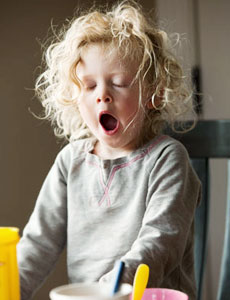The Difficulties of ADHD in Pediatrics
Building upon Dr. Kathryne Hatch’s post on 04/27/15, I’d like to expand on the idea that Attention Deficit Hyperactive Disorder (ADHD) is not an easy, simply confirmed diagnosis and introduce some basic sleep information. Diagnosing ADHD, particularly in children, can be quite a task as the effects of many sleep disorders can manifest as ADHD-like behaviors during the day.
I understand that this concept may be counterintuitive, but keep in mind, adults and children fight off sleepiness in vastly different ways.
As an adult, if I am tired at work, I can get up, take a walk around the office, go for a coffee break, grab a snack, etc. A child in a school setting cannot do these things. Since getting up and moving around (as well as sleeping on the desk) are generally frowned upon activities, school age youngsters try to stay wake in any way they can. These endeavors can manifest in several ways, but the more popular descriptions used by teachers are an “inability to sit still”, “disruptive behavior”, “jitteriness”, and/or “inability to focus on a task”. Many of these descriptions line up quite nicely with symptoms of ADHD. Teacher’s observations can be valuable, but they need to be combined with parent observations at home to give a clinician the complete picture of what is going on. Without input from parents on the child’s sleep habits, these disruptive daytime behaviors can be misclassified as ADHD, when in actuality a sleep disorder could be causing or at least contributing to these behaviors.
Why should parents be well educated on sleep issues and norms when there are clinicians who should be able to identify these issues? The simple answer is parents cannot possibly know that there is something wrong unless they are informed on what is and is not normal. Clinicians should be able to pick up on sleep issues, but all general practitioners may not be focused on sleep disorders as a general care plan.
Sleep medicine, especially in pediatrics, is a more recent specialty. There has been increased sleep education for primary care practitioners in recent years; however, parents may still experience a generic “so, how does your child sleep at night?” without specific follow up questions on key sleep specific symptoms. A parent whose child doesn’t have a problem falling asleep and sleeps through the night without incident wouldn’t be wrong in answering that question with “fine, there are no issues”. Yet, just because your child is in bed for 10 hours doesn’t mean they are sleeping for that long. Frequent arousals from sleep can cause a severe reduction in the child’s total sleep time and this can have a profound effect on their daytime behavior.
It is important to note that sleep disruptions tend to exacerbate symptoms of a wide range of psychiatric and mood disorders and vice versa. One of the more confusing aspects of making a clear cut diagnosis between ADHD and a sleep disorder is that the child may have both going on at once. Children can often present with delayed bedtimes or an increase in sleep fragmentation during the first few hours of sleep due to the nature of ADHD itself as well as the medications used to treat their daytime ADHD symptoms. This leads to shorter sleep durations, increases in disruptive daytime behaviors, and a more pronounced dependence on medications to regulate the child’s behavior. This is why a more multidisciplinary approach to the child’s health is generally in the best interest of everyone involved.
In the realm of sleep issues, the precursor to poor daytime behavior is sleep fragmentation, which are essentially arousals from sleep. These arousals can be caused by a multitude of sleep disorders, but most frequently are caused by sleep disordered breathing (sleep apnea). These arousals can be as brief as 3 seconds long and generally the child goes right back to sleep without being aware of the sleep disruption. A certain amount of arousals during sleep is normal, however, there are some tell-tale signs that an excessive amount of sleep fragmentation might be occurring. Common sleep fragmentation signs/symptoms include persistent snoring, gasping during sleep, pauses in breathing, excessive arm or leg movements, bed wetting, difficulty waking up in the morning, frequent nightmares, morning headaches, dry mouth, and habitual/excessive napping during the day.
Parents should alert their primary care physician if any of the above symptoms become prevalent in their child’s sleep, especially if the child is underweight, overweight, or obese. Early detection and treatment is the key in pediatrics as poor school performance generally goes hand in hand with an undiagnosed sleep or psychiatric disorder. A licensed professional should be consulted as early as possible to mitigate any long term effects that these disorders may cause on a child’s academic record. Any changes in sleep quality or sleep duration should be discussed with a licensed professional.*
*Sleep Foundation information on age appropriate sleep duration guidelines

